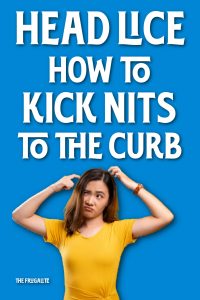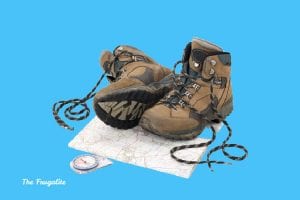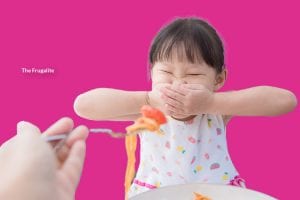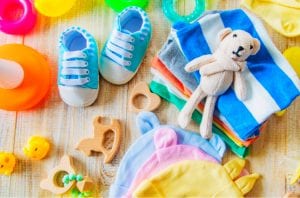(Psst: The FTC wants me to remind you that this website contains affiliate links. That means if you make a purchase from a link you click on, I might receive a small commission. This does not increase the price you’ll pay for that item nor does it decrease the awesomeness of the item. ~ Daisy)
It’s time to talk about something that, if you’re like me, just thinking about will make your head itchy. Head lice. Those tiny little bugs are the equivalent of fleas but for humans. While they don’t affect adults as often as they do the kiddos, anyone with hair has the potential to get them. Given that school has just started, and it’s one of the most common places kids get head lice, I thought it’d be a great time to talk about it. Both how to prevent getting head lice and what to do if you’ve already gotten it.
There was a period of time in middle school, when there were constant outbreaks of headlice in every grade, and we had to quickly learn both how to manage it and how to prevent future outbreaks in our home.
What are head lice?
Well, according to the Mayo Clinic:
“Head lice are tiny insects that feed on blood from the human scalp. Head lice most often affect children. The insects usually spread through direct transfer from the hair of one person to the hair of another.” (Source)
A common misconception is that headlice is the result of poor personal hygiene, but in fact, these little bugs are actually more likely to make a home on a head of clean and healthy hair, than dirty hair.
How can I prevent them?
Well, there are lots of tips and tricks that can help prevent headlice. Some things are just basic knowledge, and others are things that we had to learn in my family, and school, along the way. No one wants to keep these little bugs around! Keep reading for my advice.
Don’t share anything that touches your head
As these little bugs are very easily transferable, it’s important to avoid sharing things that touch your head or hair. This includes things such as;
- hats
- scarves
- hair brushes
- hair accessories (scrunchies, clips, headbands, etc.
- headphones
- pillows, blankets, and towels
- helmets
Preventative hair care
There are a few things you can do or put in your hair, that will make headlice less likely to make you (or your kiddo), their next home.
 Tea Tree Oil: Head lice do not like this fragrant little oil at all! There are many different hair care products that contain this little oil already, or take your go-to bottle, add some drops, and shake it up so that every time you wash your hair you’ll be using a little.
Tea Tree Oil: Head lice do not like this fragrant little oil at all! There are many different hair care products that contain this little oil already, or take your go-to bottle, add some drops, and shake it up so that every time you wash your hair you’ll be using a little.- Neem Oil: It is a fantastic oil to use for everyday hair health (just make sure you dilute it properly!), and can help with things such as frizzy hair, dandruff, and healthy hair growth. Not only that, but it works as a great preventative and treatment for head lice.
- Other Essential Oils: Lavender, peppermint, eucalyptus, and rosemary oils are all said to be repellents for the little bugs, so whether you lean towards these sents in your shampoos or add a few drops into your hair care routine, it may help give you that little edge.
- Use lots of hair product: Surprisingly, head lice actually prefer a clean head (after all, you probably prefer a clean house to a messy one too, right?) Doing things like using gel or hairspray, or keeping your hair on the slightly greasier side, may just give you that extra edge to keep the head bugs away.
- Keep your hair up: Be it braids, ponytails, or buns, keeping your hair up, and out of the way will help to keep the bugs from getting to it.
- Check for lice regularly: If you have young school-age children, I’d recommend making it a habit to give a little check for head lice at least once every 2 weeks (daily if you’ve gotten word that there are head lice going around at the school). This ensures that, if someone in your house does get it, you can hopefully get on top of it before everyone in your house has it.
What to do if you’ve already gotten head lice?
Unfortunately, you’ve got the creepy crawly little bugs, and now everyone’s head is so itchy, you feel like you could scream. It’s something that I’ve had to experience a few times, and it sure isn’t fun! Here are the steps you need to take after confirming you’ve got the little bugs.
- If it’s you’re kiddos who have gotten it, you need to make sure you call their school as soon as possible. Most schools have systems in place so they can keep the lice from becoming a major school-wide outbreak. Also notify anyone else, who may have come into contact with the lice through you or your kids. This could include friends, camps, after-school activities, or daycares.
- Start lice treatment right away. Whether you’re using an at-home remedy or an OTC one, you’re going to need to get on it ASAP and make sure you have at least 2 lice combs (especially if there is more than one person) to make sure you get them all. Thankfully, these little combs are very durable and fairly cheap. Typically, you can find them for only a couple of bucks, or in multipacks like this.
- After doing the lice treatment, comb through everyone’s head diligently to get all the head lice and nits (lice eggs)
- Wash and dry everything and anything they may have come in contact with the little pests, including linens, pillows, and toys. Heat will help kill the bugs, so use hot water, and dry on your highest heat setting to keep things clean.
- Sanitize all of your hair accessories, hair brushes, hats, and scarves.
- Vacuum all the furniture, carpets, and your vehicle. Make sure to empty out your vacuum and dispose of the contents immediately.
Home Remedy Alternatives
We’ve talked about home remedies on here before, but let’s get more specific. While the Over the Counter lice treatments like this kit are going to be one solution, I know from experience how expensive they can be, especially in a large household. They also contain some chemicals that may not be the best solution for every family. Below are some alternatives for the OTC stuff, but, if they aren’t working well enough or keep returning, you may have to switch back to the store-bought.
- Olive Oil or Coconut Oil: Olive oil is great for tons of things, including lice. Slather your hair with olive oil or coconut oil, throw on a shower cap, and let it sit overnight. This basically suffocates the lice. In the morning, grab a fine-toothed comb and start combing out those lice and nits. You might need to repeat this a few times.
- Mayonnaise: Yep, mayo can do the trick too. Apply a generous amount to your hair, cover it up with a shower cap, and leave it on overnight. Then, comb out the lice and nits in the morning. Don’t be shy about doing this more than once if needed. (Just a little warning, don’t use this method for anyone allergic to eggs…. trust me when I say it doesn’t go well, as mayonnaise is full of eggs. Can you tell we have someone with an allergy? )
- Vinegar: Vinegar, either white or apple cider, can help loosen those stubborn nits. Apply it to your hair and scalp, pop on a shower cap, and give it a few hours. Then, comb out the nits with a fine-toothed comb.
- Essential Oils: Some essential oils like tea tree, eucalyptus, or lavender are thought to repel lice. Just mix a few drops with a carrier oil like coconut or olive oil, and massage it into your hair and scalp.
- Saltwater Soak: Soak your hair in a saltwater solution (around 2-3 tablespoons of salt per quart of water) for a couple of hours. It can help loosen those nits. Afterward, comb through to get rid of them.
- Lice Comb: You absolutely need a fine-toothed lice comb. Comb through your hair every day, paying close attention to removing both lice and nits. It can take some time, but it’s a must-do step.
- Hot Air Treatment: Some folks use special hot air devices designed to blow hot air onto your scalp and hair. It’s supposed to kill lice and nits. Just make sure to follow the device’s instructions closely to avoid burns.
This is the method my mom, Daisy, always used, and while time-consuming, it works and doesn’t cost very much money at all.
Now, remember, these home remedies might work for some, but not for everyone. If things aren’t improving or you’re not sure what to do, don’t hesitate to chat with a healthcare pro or pharmacist. They can hook you up with treatments that have been thoroughly tested and proven to work. Head lice can be quite a nuisance, so it’s best to tackle them with the big guns when needed!
How do you treat head lice?
I don’t know about you, but my head is insanely itchy after writing about these little bugs. Have you ever had to deal with head lice? What types of treatments did you use? Do you have a home remedy that wound up being a bust or a great success? Let’s discuss this in the comments!
About Chloe Morgan
Chloe Morgan grew up living with a tight budget. In her late teens and early 20’s, all the lessons she’d learned started to slip, like it does for many college-age students on their own for the first time with their first credit card. As she’s gotten older, she’s started to deal with the repercussions and has taken on a frugal way of living, keeping her costs low, as she pays off debt and saves for her future. Chloe lives in Northern Ontario, Canada, with her dog, Rhea.
Check out her work on TheOrganicPrepper.com and TheFrugalite.com where she writes about food, frugality, finances, and self-reliance, or her work on Medium, where she writes about lifestyle, mental health, and writing.











2 thoughts on “Head Lice 101: How to Kick Nits to the Curb”
I would add to have a maturity level conversation with your children. Long story short, a friend of the kiddo had head lice BUT kids being kids, said “don’t say anything”. Found out from another adult and suffice it to say, a good thing my partner knew I was livid (poor kid was 2nd best in the family). Partner paid a visit and I called another parent whose child was exposed. Quite the adventure needless to say.
After a long internet search, I found a comment about using hydrogen peroxide to kill the lice. It works. Does not kill the nits, but no adult lice means no nits until the nits hatch. Mix 50/50 with water, saturate the hair/scalp with solution, let sit a few minutes, use nit comb, rinse.